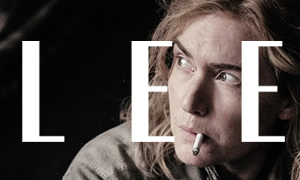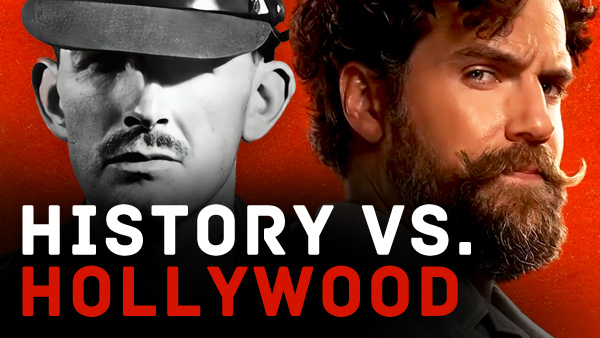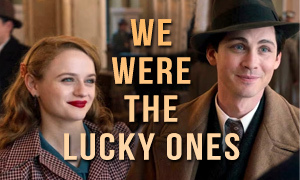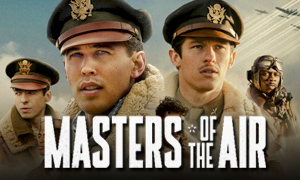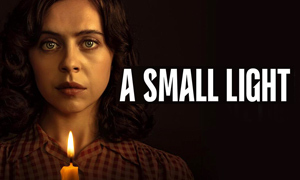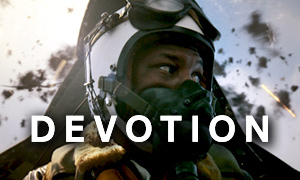Hacksaw Ridge: History vs. Hollywood
| REEL FACE: | REAL FACE: |
Andrew Garfield
Born: August 20, 1983 Birthplace: Los Angeles, California, USA | Desmond T. Doss
Born: February 7, 1919 Birthplace: Lynchburg, Virginia, USA Death: March 23, 2006, Piedmont, Alabama, USA (respiratory ailment) |
Teresa Palmer
Born: February 26, 1986 Birthplace: Adelaide, South Australia, Australia | Dorothy Doss
Born: December 16, 1920 Birthplace: Philadelphia, Pennsylvania, USA Death: November 17, 1991 (car accident) |
Sam Worthington
Born: August 2, 1976 Birthplace: Godalming, Surrey, England, UK | Jack Glover
|
Hugo Weaving
Born: April 4, 1960 Birthplace: Ibadan, Nigeria | Tom Doss
Born: abt 1894 Birthplace: Virginia |
Rachel Griffiths
Born: December 18, 1968 Birthplace: Melbourne, Victoria, Australia | Bertha Doss
Born: February 26, 1899 Birthplace: Virginia, USA Death: April 6, 1983, Lynchburg, Virginia, USA |
Nathaniel Buzolic
Born: August 4, 1983 Birthplace: Sydney, Australia | Harold Doss
Born: June 19, 1922 Birthplace: Lynchburg, Virginia, USA Death: March 13, 2007, Kearneysville, West Virginia, USA |
Matt Nable
Born: March 8, 1972 Birthplace: Australia | Gerald Cooney
|
When did Desmond Doss join the U.S. Army?
In researching the Hacksaw Ridge true story, we learned that Desmond Doss was drafted into the United States army in April 1942. He could have gotten a deferment because he worked as a ship joiner at a shipyard in Newport News, Virginia, but he wanted to serve his country. Electing not to bear arms, he made his way into the army medical corps. During March 1944, he shipped out along with the rest of the 77th Division (the Statue of Liberty Division) for the Pacific Theater, first to Guam, then to Leyte in the Philippines, and finally to partake in the allied invasion of Okinawa, an island 340 miles south of mainland Japan (only the latter is chronicled in the movie). "I felt like it was an honor to serve God and country," Desmond said. "We were fightin' for our religious liberty and freedom." -The Conscientious Objector Documentary
Why did Desmond T. Doss refuse to bear arms during WWII?
Fact-checking Hacksaw Ridge confirmed that he refused to carry a weapon because of his personal and religious beliefs as a Seventh-day Adventist, which is part of the Protestant sect of Christianity. "My dad bought this Ten Commandments and Lord's Prayer illustrated on a nice frame, and I had looked at that picture of the Sixth Commandment, 'Thou shalt not kill.' There's a picture that had Cain and he killed his brother Abel, and I wonder how in the world could a brother do such a thing? I've pictured Christ for savin' life, I wanna be like Christ go savin' life instead of takin' life and that's the reason I take up medicine."
A defining moment in Desmond's life that perhaps helped to further shape his attitude toward guns and violence happened when he was a boy. His father and uncle were drunk and got into a fight (the movie implies the fight was between Desmond's father and mother). His father pulled a gun on his uncle but his mother stepped in. She called the police and told Desmond to hide the gun. After doing so, young Desmond returned just in time to see his father being loaded into a black police wagon in handcuffs. Desmond believed that his father would've killed his uncle (his mother's brother) if his mother hadn't stepped in. Desmond vowed that would be the last time he ever touched a gun. -The Conscientious Objector Documentary
Did Desmond Doss always have a desire to help others, even before joining the army?
Yes. "He was always helpful to people," said his brother Harold, who was his best friend when they were boys. "He was not one that would give up. He didn't know how." The Great Depression left their father, a carpenter, despondent and turning to alcohol at times (though the movie greatly exaggerates this and makes him abusive). Instead, Desmond took after his mother, Bertha Doss, who taught him about compassion, helping others, and the importance of following Christ. His sister Audrey recalled a time when they were young and Desmond went the extra mile to help victims of an accident.
"Anyone sick he'd be there," said his sister. "It was announced on the radio, we didn't have TVs in those days, it was announced there was an accident on Route 29 and they needed some blood right away to save this woman's life. He walked three miles to that hospital and walked three more miles back home after he gave blood. Two days later, a call came back over the radio, they need more blood. There he goes again, walks the three miles, then walks three miles back." In the movie, Desmond is motivated to give blood in order to get to know Dorothy, who works as a nurse, but in real life he met Dorothy Schutte at church. -The Conscientious Objector Documentary
Was Dorothy really a nurse?
Dorothy Schutte was not a nurse when she met Desmond. She didn't get her nursing degree until years later, after the war, when she needed to help support their family. Desmond's injuries and disabilities from the war left him unable to have a full-time job. -Hero of Hacksaw Ridge
When did Desmond Doss and Dorothy Schutte get married?
The Hacksaw Ridge true story reveals that Desmond Doss married Dorothy Schutte on August 17, 1942, before going on active duty. "The reason I married him [was] because it seemed I could trust Desmond," says Dorothy. "He was a good Christian and I figured he would help me go to Heaven. That's what I told my mother. ... He appreciated me because I've never kissed any other men. He was the first one I ever kissed." Desmond first met Dorothy, a fellow Seventh-day Adventist, at church in Lynchburg, Virginia when she came through from Richmond selling Adventist books. The movie changes the timeline of their marriage (he didn't miss their wedding day because he was denied a pass and then put in a holding cell).
Did the army really want to send Desmond Doss to a conscientious objectors camp?
Yes, but he tried to explain to the army that he still wanted to be in the military and do his part, just without having to kill. For this reason, he told them he wasn't a conscientious objector but rather a "conscientious cooperator." He believed that the war was justified but that killing was nevertheless wrong. Like in the Hacksaw Ridge movie, when he told the army he wanted to be a medic, they replied by telling him they would decide what his position would be, not him. In the end, he was allowed to remain in the army but with the "conscientious objector" classification, a label he did not believe was accurate. -The Conscientious Objector Documentary
Did fellow soldiers really accuse Desmond of being a coward and pick on him?
Yes. "He knew he was gonna have difficulty," said his sister Audrey, "because he doesn't use a gun." He went to South Carolina to join the 77th Division and begin his basic training at Fort Jackson. The army initially refused his request to be a medic and assigned him to a rifle company, figuring that peer pressure (and intimidation) might convince him to handle a weapon. His fellow soldiers regarded him as a pest and thought he was putting on an act. The Hacksaw Ridge true story confirms that, like in the movie, they ridiculed him and didn't want to associate with him. "They made fun of me," says Desmond, who always carried a Bible in his pocket and prayed before bed. They called him "Holy Jesus" and "Holy Joe."
"You know, he'd say his prayers at night and everything, and some guys took their shoes and threw shoes at him and threw things at him, made fun of him right out in the open," recalled Ken Lafond, a battalion scout from Tucson, Arizona. "I don't think I could have taken what that guy did. I don't think I could have taken it, but he hung in there. He hung in there regardless of what they said or what they did." Contrary to the movie, there seems to be no record of Desmond ever getting pulled out of bed and beaten in the night. In addition, the movie's early antagonist, Smitty (portrayed by Luke Bracey), appears to be a fictional composite of some of Desmond's tormentors.
The Medal of Honor recipient remembers some of the threats. "One fella, he told me, 'I swear to God Doss, you go into combat, I gonna shoot you.'" After a month of being in the infantry, the army decided to grant him his wish and transferred him back to the medical corps. -The Conscientious Objector Documentary
Did Desmond refuse to do any work on Saturdays?
Yes. As a Seventh-day Adventist, he believed in an adherence to the Fourth Commandment, which says to keep the Sabbath day holy. This meant from sundown Friday until sundown Saturday, he devoted himself to prayer. Some of his fellow soldiers thought it was a convenient way to get out of doing any work. Desmond's captain in the medical corps, Captain Solomon Statman, threatened to court-martial him if he kept asking for a pass to go to church on Saturdays. -The Conscientious Objector Documentary
Did Jack Glover try to get Desmond transferred out of his battalion?
Yes. "I went to my battalion commander, Colonel Gerald Cooney," recalled the real Jack Glover (portrayed by Sam Worthington in the movie), "and I suggested that, in my opinion, Doss should be transferred." It should be noted that after later fighting alongside Desmond, Jack Glover's opinion of him changed entirely. "He was one of the bravest persons alive, and then to have him end up saving my life was the irony of the whole thing." -The Conscientious Objector
Did Desmond's officers convene a hearing to have him discharged?
Yes, as his officers grew less tolerant of his refusal to bear arms or work on Saturdays, they convened a meeting to discharge him on a Section 8 for mental instability. Sergeant Howell, portrayed by Vince Vaughn in the movie, came to Desmond's tent and told him to turn in his aid kits, that he was no longer a medic. Colonel Gerald Cooney was pressured into holding the hearing and Desmond was called to answer the mental instability charge. "I told him, 'Sir, I cannot accept no Section 8 off my religion.' To me, I feel I'd be a very poor Christian to accept a Section 8 off my religion." Desmond told Colonel Cooney he would be just as good of a soldier as him. The officers relented and knew Washington would never approve a Section 8 solely on religious grounds. -Conscientious Objector Documentary
Did an officer threaten to court-martial Desmond for not touching a rifle?
Yes, but things didn't escalate as far as they do in the movie. While training in the U.S., an officer by the name of Capt. Cunningham got into an argument with Desmond and told him only those men who participated in rifle training were allowed passes to go into town. After Desmond told him that he didn't have to touch a weapon and that it was stated in his file, the captain tried to humiliate him by forcing a rifle into his hands in front of the men. The captain told him to take the rifle or he would be court-martialed, but Desmond let it fall to the ground. As Cunningham started telling him that he was court-martialing him, another officer stepped in and told Cunningham to back off and respect what was written right there in his record. Cunningham relented and gave Desmond the pass, but it didn't stop him from continuing to make Desmond's life a living hell. In the movie, no other officer steps in to stop Cunningham, and the altercation leads to Desmond being put in a holding cell before the hearing.
In real life, Cunningham later denied Desmond passes to see his wife and denied him a two-week furlough to see his brother Harold, who was on his last furlough before heading overseas with the Navy. Desmond was crushed that he likely wouldn't be able to see Harold before he shipped out. The movie instead has Desmond (Andrew Garfield) despondent after he is forced to miss his own wedding, a scenario that is fiction (he was already married by then). -The Conscientious Objector
Did Desmond's father contact his own former commanding officer to help prevent Desmond from being court-martialed?
No. In the movie, Desmond's father, Tom Doss (Hugo Weaving), contacts his former commanding officer who writes a letter that stops Desmond from being court-martialed (a scenario that never happened in real life). According to the true story, when Desmond was denied leave for refusing to touch a gun, his father contacted the chairman of the church's War Service Commission in Washington, Carlyle B. Haynes. The chairman made a call to the regimental commander, Colonel Stephen S. Hamilton, asking if it was necessary for him to come investigate the situation with Desmond Doss. The colonel told him no and that they would straighten things out. Desmond still had to wait for his furlough, but as a result of his father's actions, he was given a 3-day pass to go home and see his brother Harold before he returned to the Navy to go overseas. -Hero of Hacksaw Ridge
Did Desmond really get to see Dorothy before shipping out for WWII's Pacific Theater?
Yes. "When the train pulled out, I waved goodbye to her, and I tell you, it leaves you a very low feeling, knowing you may have seen your wife for the last time," recalled Desmond. "I tell ya it's hard to keep from cryin', but I try not to cry because we want to be brave to encourage each other. But the tears came though after the train pulled out." The train went right past Desmond's boyhood home. His father stood looking for Desmond but their eyes never met. Desmond threw a brick with a note wrapped around it, hoping his father would see it. -The Conscientious Objector Documentary
Did Desmond treat an enemy soldier while he was out looking for his own men?
It seems likely that this is true, at least according to the stories told by some of his comrades who found an American bandage on an enemy soldier. "I don't know how bad the man was hit," said a fellow soldier, "but there was one found with a bandage on his arm, an American bandage." During an interview, Desmond recalled an instance where he tried to help a wounded Japanese soldier. "The fellas pulled a gun on me. They used some strong language. 'If you use that stuff on blankety-blank, we'll kill you!' And I knew they meant it. So I knew better than to try to take care of a Japanese." We found no evidence that Desmond lowered wounded Japanese soldiers down the cliffside like in the movie. However, Desmond did have a willingness to help anyone who was injured. He often went out in the darkness looking for fallen comrades to bring to safety. His heroics didn't go unnoticed, as fellow soldiers were often amazed he was still alive. -The Conscientious Objector Documentary
Why did the U.S. invade Okinawa?
A fact-check of the Hacksaw Ridge movie supports that the United States invaded the island of Okinawa in order to use the island as an air base for an invasion of mainland Japan, which is only 340 miles away. Japanese forces were deeply entrenched on the island, hammering American troops from caves and tunnels, in addition to setting booby traps. Private Desmond Doss and his battalion were ordered to ascend a jagged 350-foot escarpment called the Maeda Escarpment, which was heavily fortified with Japanese defenders. -Medal of Honor: Oral Histories
How dangerous was the Maeda Escarpment, a.k.a. Hacksaw Ridge?
Okinawa's Maeda Escarpment is an approximately 350-foot high ridge that runs across most of the island of Okinawa. "The Japanese had been there for years," said the real Desmond Doss. "They had that mountain honeycombed and camouflaged, it looked like natural terrain. That's what we had to face." The Japanese were hiding everywhere, in caves, tunnels, holes and pillboxes, ready to cut down any enemies who approached. The escarpment was so deadly it was dubbed "Hacksaw Ridge."
U.S. soldiers who were involved in the battle to take the ridge recall stacking the bodies of fallen Americans as high as they could reach and wading through 200 yards of mud puddles that were saturated with blood. The machine gun fire was sometimes so thick that men would be cut in half. -The Conscientious Objector Documentary
Did they really use cargo nets to ascend the ridge?
Yes, and medic Desmond Doss was one of the three men who volunteered to go up the ridge and hang the cargo nets (something not shown in the movie). They were the same cargo nets that the men had used to climb down from the army personnel carriers into the landing crafts that took them ashore. In the photo below, Desmond is seen standing on top of the ridge. The photo doesn't convey the sheer danger he was in up there. The photographer refused to get any closer for fear he would be hit by Japanese fire. -The Conscientious Objector Documentary
Was Desmond ever forced to choose between killing to protect his men or standing by his convictions?
Yes. As we explored the Hacksaw Ridge true story, we learned that while trying to get some sleep near the bottom of the Maeda Escarpment on Okinawa, Desmond Doss and a fellow soldier heard the voices of Japanese soldiers coming from a hole that was just below them. Desmond feared they would be discovered. "Between me and my buddy was these hand grenades," said Desmond. "All I had to do was just pull the pin and I knew I had some Japanese." Realizing that taking out the enemy in the hole would protect his men from possible death, he later said that this was the greatest temptation of his life. "I thought of what I heard before, 'Thou shalt not kill.' God gave life and I didn't want to take life." -The Conscientious Objector
Were the medics prime targets for the Japanese?
Yes. The Japanese focused on taking out medics in order to demoralize their enemy. "They preferred to get us above anyone else," Desmond said. "They would let the infantry get by just to pick off a medic, because if they killed the medics, it broke down the moral of the men." Like in the movie, the medics removed any identifying symbols. -The Conscientious Objector Documentary
Did Desmond Doss really stay on the ridge while most of his fellow soldiers retreated back down?
Yes. Facing heavy mortar, artillery and machine gun fire, the majority of the battalion retreated back down the Maeda Escarpment, leaving dozens of casualties behind to face death or capture at the hands of the Japanese. "I had these men up there and I shouldn't leave 'em," said Desmond. "They were my buddies, some of the men had families, and they trust me. I didn't feel like I should value my life above my buddy's, so I decided to stay with them and take care of as many of them as I could. I didn't know how I was gonna do it." Like in the Hacksaw Ridge movie, he dragged them to the edge of the cliff and attempted to lower them down the escarpment. -Medal of Honor: Oral Histories
Did Desmond really have to lower the wounded men down the cliff's edge one by one?
Yes, and he didn't have enough rope to do it, so he had to come up with another way. "I didn't have enough rope to do the job like it should be done," recalled the real Desmond Doss, "then the Lord brought to my mind that knot I learned in West Virginia that I'd never seen or heard of before." Falling back on his experience helping rescue flood victims when he was younger, Doss fashioned a special sling that enabled him to lower the men one by one to safety. "So I just kept prayin', 'Lord, please help me get more and more, one more, until there was none left, and I'm the last one down.'" -Medal of Honor: Oral Histories
Did a Japanese soldier's gun keep jamming when he had Desmond in his sights?
While lowering the men down the ridge, the Japanese had a clear shot at Desmond Doss. Though it's not depicted in the movie, one Japanese soldier recalled having Desmond in his sights, but every time he went to fire, his gun jammed. -The Conscientious Objector Documentary
How many men did Desmond Doss save on the ridge on Okinawa?
Army medic Desmond Doss had found a way to single-handedly rescue roughly 75 of his wounded comrades while under heavy mortar and gunfire. Doss estimated the number of lives he saved to be 50, but his commanding officer wanted to credit him with saving 100 lives, so they compromised at 75 (Library of Virginia). It was for this feat that President Truman awarded Doss the Medal of Honor on October 12, 1945. "When my time came, I went up," said Doss of the ceremony. "President Truman, he came out and he stepped over the line, he caught me by my hands, shook my hand like I was an old-time friend, somebody he had known all his life. He didn't even give me a chance to get nervous" (Medal of Honor: Oral Histories).
How close did Desmond Doss come to being killed or wounded while rescuing 75 of his fellow soldiers?
The real Desmond Doss considers it a miracle that he made it off the ridge on Okinawa. "When you have explosions and bursts so close you can practically feel it, and not get wounded up there when I should have been killed a number of times. I know who I owe my life to as well as my men. That's why I like to tell this story to the glory of God, because I know from the human standpoint, I should not be here." The true story reveals that he spent 12 hours up on the ridge rescuing the men, averaging one man every 10 minutes. -Medal of Honor: Oral Histories
Did they put the final assault to take the ridge on hold while Desmond read his Bible?
Yes. The final assault to take the Maeda Escarpment happened on the morning of May 5, 1945, a Saturday, the day of Sabbath, which the Fourth Commandment says should be devoted to prayer. Given that Desmond was the only medic left in B Company, he agreed to go but requested that he first be given time to read his Bible. The delay was approved up the chain of command and the assault was put on hold until Desmond finished his devotions. That day, the 307th Infantry Regiment of the 77th Infantry Division overtook Hacksaw Ridge for good. -The Conscientious Objector Documentary
Did Desmond T. Doss nearly get blown up by a hand grenade?
Yes. On the night of May 21, 1945, just a half mile past the escarpment on Okinawa, Desmond's unit inadvertently walked into a company of Japanese soldiers. The unit engaged in hand-to-hand combat with the enemy and Desmond scrambled to treat the wounded. "They begin to throw these hand grenades," recalled Desmond. "I saw it comin'. There was three other men in the hole with me. They were on the lower side, but I was on the other side lookin' when they threw the thing. I knew there was no way I could get at it. So I just quickly took my left foot and threw it back to where I thought the grenade might be, and throw my head and helmet to the ground. And not more than half a second later, I felt like I was sailin' through the air. I was seein' stars I wasn't supposed to be seein', and I knew my legs and body were blown up." The blast left 17 pieces of shrapnel embedded in Desmond's body, mostly in his legs. -The Conscientious Objector Documentary
Did the real Desmond Doss get shot by a Japanese sniper?
Yes. Director Mel Gibson decided to leave this out of the movie because he felt audiences would find the heroic circumstances under which it happened too hard to believe, especially after Desmond had just taken the brunt of a grenade blast to save his fellow soldiers. After the grenade left him with 17 pieces of shrapnel stuck in him, Desmond waited for five hours until fellow soldier Ralph Baker was able to reach him. Baker, along with a few other men, carried Desmond on a litter (stretcher) through an intense enemy tank attack. As they were carrying him, he saw a guy on the ground badly wounded. Desmond rolled off the stretcher and crawled over to patch the man up. Desmond gave up his stretcher to the man, but while waiting for help to come back, he was wounded again, this time by a sniper's bullet that shattered his left arm. He fashioned a splint out of a rifle stock and crawled the remaining 300 yards under fire, eventually reaching the safety of an aid station. He was transported to the hospital ship Mercy. -The Conscientious Objector Documentary
Did he lose his Bible when he was wounded?
Yes. In a letter home to his wife Dorothy, written on May 31, 1945, he informed her that while being treated on the hospital ship Mercy, he realized he had lost his little Bible when he was wounded. It was the Bible she had given him before he shipped out. He told Dorothy that he hoped someone had found it and was holding it for him. "That was my main source of strength all during the war and in the service," Desmond said later, "and then when I lost it, I was lost." The men of Company B learned that it was missing and risked their lives to find it for Desmond, which they did. -The Conscientious Objector
Why didn't Desmond Doss ever compromise a little and carry a weapon?
"I knew if I ever once compromised, I was gonna be in trouble," said Desmond, "because if you can compromise once, you can compromise again." -The Conscientious Objector Documentary
What did Desmond Doss do after the war?
Desmond's life wasn't easy after the war. His wounds left him 90% disabled. He spent five and a half years in and out of VA hospitals and was discharged in August 1951. He had lost 5 ribs and one lung due to tuberculosis contracted on the island of Leyte in the Philippines and made worse on Okinawa. The military continued to treat him with antibiotics, which he believed by 1976 had made him completely deaf (possibly from giving him too high of a dose). He lived in silence for twelve and a half years, until he received a cochlear implant in 1988.
After WWII, Desmond received a modest pension from the military, but due to his disabilities from his injuries, his wife Dorothy got her nursing degree and had to work full-time to help with their income (in the movie she is already a nurse when they meet). He cashed in his Government life insurance policy to buy four acres in Rising Fawn, Georgia, using much of the money to fix up the property. He, his wife Dorothy, and their son Desmond Jr. (who they called "Tommy" after his middle name) resided in a small log cabin that he built on the land. They grew their own fruits and vegetables to help sustain themselves and eventually farmed the land. Desmond also worked part-time as a cabinetmaker and tried various other jobs that his health would allow, including raising tropical fish, door-to-door sales, and working as a maintenance man. Later in life, Desmond's wife Dorothy developed breast cancer and passed away from injuries sustained in a car accident while Desmond was driving her to a hospital in November 1991. He married Frances Duman in 1993. They were together until his death in 2006. -The Conscientious Objector
Desmond Doss Interviews & Related Videos
Dig deeper into the Hacksaw Ridge true story by watching the Desmond Doss interviews below. The Medal of Honor interview features Desmond opening up about his decision not to bear arms, and the This Is Your Life episode reunites him with some of his former comrades.
Link-to-Learn More:
